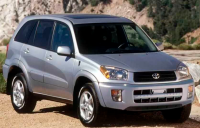Article about the confrontation between the Honda CR-V and the Toyota RAV4: a comparison of technical specifications, exterior, interior, driving characteristics, price tag.
For many years, Honda has been waging a fierce "war" against Toyota, the purpose of which is to gain a larger market share and, accordingly, make more money.
As one of the most striking examples of the confrontation can recall the duel between the Toyota Camry and Honda Accord, which ended in the victory of the first, because the latest generation Accord plays in a completely different category, making the main emphasis on "sport" rather than "business".
Another confrontation is observed between crossovers CR-V and RAV4, which today we intend to consider in more detail to determine the advantages and disadvantages of each model and, perhaps, to name the best of them.
The exterior of the Honda CR-V and Toyota RAV4
 To compare the appearance of cars - it is not grateful, as everyone has his own ideas about beauty, so we just note the main features of the exterior of each of the crossovers.
To compare the appearance of cars - it is not grateful, as everyone has his own ideas about beauty, so we just note the main features of the exterior of each of the crossovers.
Honda CR-V has a pleasant and stylish appearance. "The muzzle" is made in the corporate style of the Japanese brand, which has already managed to try on such models as the Civic and HR-V. Eye-catching expressive headlights, hexagonal radiator grille and front bumper, complemented by sections of LED foglights.
Sufficiently powerful profile shows padded wheel arches, stylish wheel disks and sloping roof line. The stern also keeps up, flaunting the formidable parking lights, the large rear spoiler and the luggage compartment door.
 Toyota RAV4, as it seems to us, looks more youthful. The front part of the body demonstrates a "sharp" look of the head optics, a neat radiator grille and a powerful front bumper with a huge air intake and a pair of round fog lamps.
Toyota RAV4, as it seems to us, looks more youthful. The front part of the body demonstrates a "sharp" look of the head optics, a neat radiator grille and a powerful front bumper with a huge air intake and a pair of round fog lamps.
The crossover's profile is emphasized by a sloping roof line, plump wheel arches and upward-trending window line. The stylish stern is represented by large headlamps, an impressive rear spoiler and a large fifth door.
External measurements of the Honda CR-V and Toyota RAV4:
Specifications | Honda CR-V | Toyota RAV4 |
Length, mm | 4586 | 4605 |
Width, mm | 1855 | 1845 |
Height, mm | 1689 | 1670 |
Wheelbase, mm | 2660 | 2660 |
As we see, the external measurements of the cars are plus or minus comparable. But the height of CR-V ground clearance is 11 mm more - 208 vs. 197 mm, and it means that on impassability Honda allows feeling more freely.
Honda CR-V vs Toyota RAV4 interior design
 Both Honda and Toyota have high-quality interior, but the interior of the first looks much more modern and "fresh", which is seen the merit not only of the stylish "steering wheel" and the digital dashboard, but also more effectively played with the central part of the torpedo.
Both Honda and Toyota have high-quality interior, but the interior of the first looks much more modern and "fresh", which is seen the merit not only of the stylish "steering wheel" and the digital dashboard, but also more effectively played with the central part of the torpedo.
The quality of materials and assembly will not cause questions even from demanding customers.
 In terms of the amount of free space the cars have full parity, and this applies to both the seats of the first row, and the rear sofa, which can easily accommodate three adults.
In terms of the amount of free space the cars have full parity, and this applies to both the seats of the first row, and the rear sofa, which can easily accommodate three adults.
The volume of a luggage compartment is also comparable - 577 liters in Toyota and 522 liters in Honda with a standard saloon layout. However, it is necessary to notice that unlike RAV4, CR-V engineers have provided an opportunity to fold the second row of seats directly from a luggage compartment. In Toyota for this you need to open the back door and fold the back of the couch from the cabin, which is not critical, but less convenient.
A couple of words should be said about visibility, which in both cars leaves much to be desired - at least, if to compare models with their previous generations. However, the softening factor can be considered the increased quantity of electronic helpers.
Despite the comparable dimensions, the interior of CR-V is perceived more comfortable and spacious.
Honda CR-V and Toyota RAV4 Specifications
 The powertrain lineup of the Honda CR-V available to markets includes:
The powertrain lineup of the Honda CR-V available to markets includes:
1. 2-liter 16-valve gasoline engine, reproducing 150 hp and 190 Nm of torque. With it, the car accelerates to the first hundred in 11.9 seconds and can reach a maximum mark of 188 km / h. Fuel consumption in the combined cycle is less than 7.5 liters/100 km (passport data).
2. 2.4-liter gasoline engine, which generates 186 hp and 244 Nm of torque, which is enough to break a hundred in 10.2 seconds and the car reaches 190 km/h. In spite of the big capacity, fuel consumption in a combination mode is comparable to the 2-liter engine and is 7.8 l/100 km.
In both cases, the power plant is paired with a modern stepless variator and four-wheel drive system with a multi-disk clutch, allowing to transfer up to 50% of torque to the rear axle.
 The Toyota RAV4 is available on the market with one of three powertrains:
The Toyota RAV4 is available on the market with one of three powertrains:
1. A 2-litre petrol engine with 146 hp and a maximum tractive power of 187 Nm. It can be equipped with a six-speed manual transmission or a continuously variable variator. Acceleration to a "hundred" requires 10.2-11.3 seconds depending on the type of pre-installed transmission and the presence / absence of all-wheel drive. Fuel consumption ranges from 7.4 to 7.8 liters in the combined cycle and the top speed is 180 km/h.
2. The 2.5-liter gasoline engine delivers 180 hp and 233 Nm of torque. This engine provides acceleration to a hundred in 9.4 seconds and can reach 180 km/h. Average fuel consumption is 8.6 l/100 km.
It is paired with the 6-speed automatic transmission without any alternatives, as well as a system of a switchable all-wheel drive.
3. A 2.2-liter diesel engine generating 150 hp and 340 Nm of torque. Such engine is aggregated with automatic transmission and a system of a switched all-wheel drive. Dynamic characteristics: acceleration up to a hundred in 10 seconds, maximum speed of 185 km / h and the average consumption - 6.7 liters/100 km.
So, if you need a car with a gasoline engine, in terms of range and dynamic characteristics Honda and Toyota are comparable, but if you need a diesel - there is only one option, and that is Toyota.
Driving performance of Honda CR-V vs Toyota RAV4
Despite the presence of a four-wheel drive, consider the CR-V and RAV4 on the role of off-road conqueror is not worth it. Their destiny - broken asphalt, countryside and all kinds of obstacles of urban "jungle" (railroad crossings, "speed bumps", curbs, etc.).
In terms of driveability cars are very similar, providing a soft and comfortable ride on asphalt. At the same time CR-V, as it seemed to us, is better in turns and more responsive to the actions of the driver, while RAV4 behaves better on country roads and broken asphalt.
Safety Honda CR-V vs Toyota RAV4
 Despite the fact that all modern cars provide plus or minus comparable level of security, a set of pre-installed systems can vary dramatically. For example, the CR-V's arsenal includes the following systems and equipment:
Despite the fact that all modern cars provide plus or minus comparable level of security, a set of pre-installed systems can vary dramatically. For example, the CR-V's arsenal includes the following systems and equipment:
* ABS/EBD system;
* VSA system;
* Maneuvering assistant AHA;
* Hill Start Assist;
* P, W, DWS;
* Immobilizer;
* Central locking system;
* ISOFIX fasteners;
* front/side airbags + safety curtains;
* Driver fatigue tracking system and lane control.
The list of RAV4 safety systems is represented by:
* TSC system;
* ABS/EBD systems;
* Hill descent/climb assist;
* BAS system;
* Traction control;
* VVTi technology;
* frontal/side airbags + safety curtains;
* Traffic sign reading system;
* Blind spot monitoring and so on.
Here it is necessary to notice that Toyota in base offers the buyers much more equipment, and a part of Toyota optional equipment is not accessible for Honda owners at all.
Price and equipment of Honda CR-V and Toyota RAV4
Minimum cost of Toyota RAV4 starts from the mark in 25 thousand dollars for front-wheel drive modification and 32 thousand dollars for all-wheel drive version. The list of standard equipment includes:
* Electrically adjustable and heated exterior mirrors;
* Light sensor;
* Central locking;
* ABS, ABS, EBD;
* Front fog lights;
* LED parking lights;
* Headlight washer;
* Immobilizer;
* TRC, TSC, HAC systems;
* Tire pressure sensor;
* 4-speaker audio system;
* Heated front seats;
* Frontal/side airbags + safety curtains.
The cost of the Honda CR-V starts at 33 thousand dollars, and the list of basic equipment includes:
* 8 airbags;
* VSA, EPS, BA, DWS, ABS, Hill Start Assist and maneuvering assistant AHA;
* Immobilizer;
* Central locking;
* Alarm system;
* Audio system with 4 speakers;
* LED headlights;
* Alloy wheels R18;
* Climate control;
* Full electric package;
* Heated front seats;
* Light sensor;
* Cruise control and other.
Conclusion
Both cars deserve buyers' attention and boast a quality interior, modern looks, and plenty of equipment. Nevertheless, our favorite becomes the Honda CR-V, as it has more versatile appearance, greater ground clearance, a more modern, thoughtful and quiet interior, as well as excellent handling on the highway.
But here it is necessary to notice that more recently Toyota has presented new fifth generation RAV4 which cardinally changes balance of forces in this opposition.




